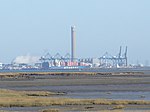Grain Power Station
AlstomBuildings and structures in KentCogeneration power stations in EnglandCommons category link is defined as the pagenameEnergy infrastructure completed in 1979 ... and 9 more
Energy infrastructure completed in 2010EngvarB from September 2013MedwayNatural gas-fired power stations in EnglandOil-fired power stations in EnglandPages with disabled graphsPower stations in South East EnglandTowers completed in 1979Uniper

Grain Power Station is a 1,275 megawatts (1,710,000 hp) operational CCGT power station in Kent, England, owned by Uniper (formerly E.ON UK). It was also the name of an oil-fired, now demolished, 1,320MW power station in operation from 1979 to 2012.
Excerpt from the Wikipedia article Grain Power Station (License: CC BY-SA 3.0, Authors, Images).Grain Power Station
Transformer Road,
Geographical coordinates (GPS) Address Nearby Places Show on map
Geographical coordinates (GPS)
| Latitude | Longitude |
|---|---|
| N 51.446111111111 ° | E 0.71305555555556 ° |
Address
Transformer Road
Transformer Road
ME3 0AR , Isle of Grain
England, United Kingdom
Open on Google Maps








